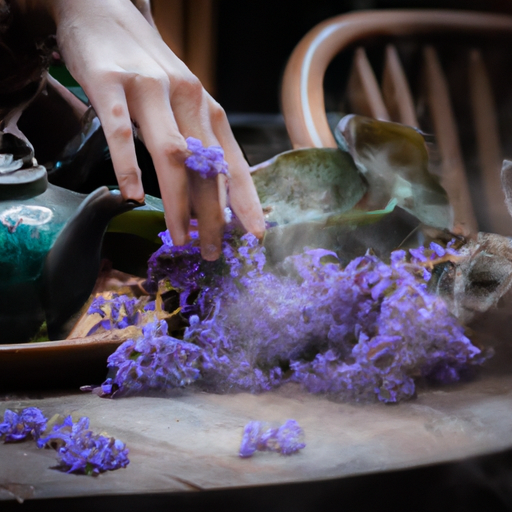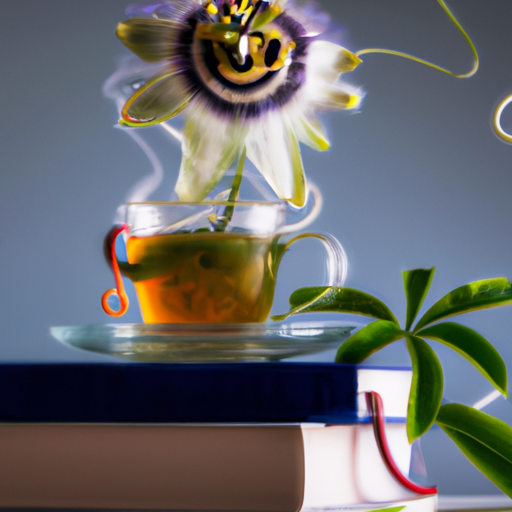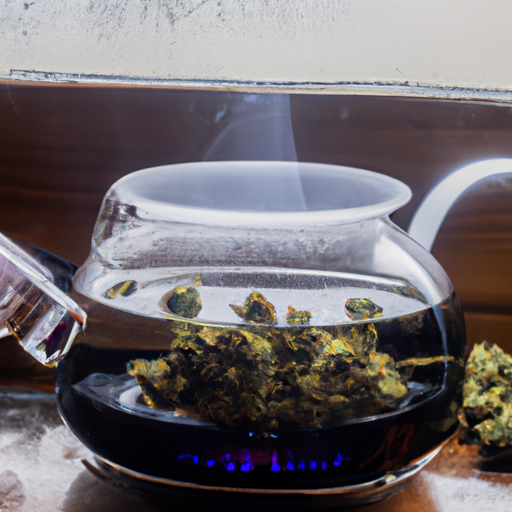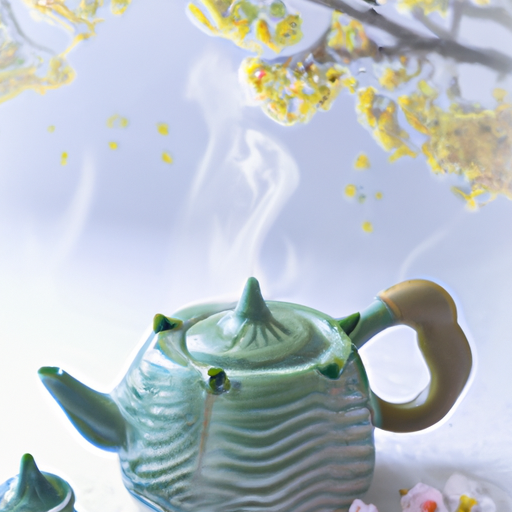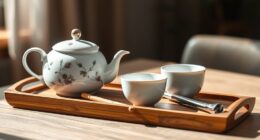Are you tired of the same old tea flavors? Looking to add a touch of elegance and sophistication to your daily cuppa? Well, I have just the solution for you.
Imagine sipping on a warm, fragrant brew infused with the delicate petals of flowers. It’s a sensory experience like no other, transporting you to a realm of tranquility and bliss.
Just like a master chef uses a variety of herbs and spices to create culinary masterpieces, tea enthusiasts have discovered the art of incorporating flower petals into their brews. These petals not only enhance the visual appeal of your tea but also infuse it with their unique flavors and aromas.
In this article, we will explore the world of floral tea and uncover the best flower petals to elevate your tea-drinking experience. From the timeless beauty of rose petals to the calming essence of lavender petals, we will dive into a realm of botanical delights.
So, get ready to embark on a journey of taste and discover the perfect flower petals to make your tea truly extraordinary.
Key Takeaways
- Rose petals add a delicate and fragrant essence to tea with therapeutic qualities.
- Lavender petals provide a soothing and aromatic essence to tea, aiding in digestion.
- Chamomile petals create a calming effect in tea, reducing anxiety and aiding digestion.
- Jasmine petals add a floral taste to tea, enhancing the scent and providing antioxidants.
Rose Petals
You’ll love the delicate and fragrant essence that rose petals bring to your tea, creating a mesmerizing blend that transports you to a blooming garden.
Rose petals have been used for centuries in various cultures for their therapeutic qualities and exquisite taste. Not only do they add a touch of elegance to your tea, but they also offer numerous health benefits.
Rose petal tea is known for its calming properties, helping to reduce stress and anxiety. It’s also rich in antioxidants, which can boost your immune system and promote overall well-being. Additionally, rose petals have anti-inflammatory properties and can aid in digestion.
Now, let’s transition to the benefits of lavender petals, another popular choice for tea enthusiasts.
Lavender Petals
Indulge in the soothing and aromatic essence that lavender adds to your favorite cup of tea. As the delicate lavender petals infuse in hot water, they release a fragrant aroma that instantly relaxes the mind and calms the senses.
The subtle floral notes of lavender provide a gentle and refreshing taste to the tea, creating a delightful experience with every sip. Not only does lavender enhance the flavor of the tea, but it also offers various health benefits, such as promoting relaxation, reducing anxiety, and aiding in digestion.
Infusing lavender in tea can be a wonderful way to incorporate the benefits of rose petals, while adding a unique and soothing touch to your tea-drinking ritual.
Now, let’s move on to exploring the enchanting properties of chamomile petals.
Chamomile Petals
Discover the soothing and calming effect of chamomile as it infuses in warm water, creating a tranquil and serene experience with every sip.
Chamomile petals are not just a beautiful addition to tea, but they also offer numerous health benefits. Known for their calming properties, chamomile can help reduce anxiety, promote sleep, and alleviate digestive issues. Its anti-inflammatory properties may also help with skin conditions like eczema and acne.
There are various ways to incorporate chamomile petals into your tea recipes. You can simply steep the petals in hot water for a few minutes or mix them with other herbs like lavender and mint for a delightful blend.
As we move on to exploring jasmine petals, get ready to indulge in the exotic and fragrant world of floral teas.
Jasmine Petals
Jasmine petals are a wonderful addition to infuse tea with a fragrant and floral taste. They not only enhance the scent and appearance of the tea, but they also provide antioxidant benefits. The delicate aroma of jasmine petals creates a soothing and relaxing experience while sipping on a cup of tea. It makes it a perfect choice for those looking to indulge in a calming and rejuvenating beverage.
Infuse Tea with a Fragrant and Floral Taste
Enhance your tea with a delightful and aromatic twist by infusing it with flower petals. Not only do flower petals add a beautiful and colorful touch to your tea, but they also impart a fragrant and floral taste that can elevate your tea-drinking experience.
There are various ways to incorporate flower petals into your tea. You can use them to create unique and flavorful blends, or simply add them to your favorite tea for a subtle infusion of floral notes.
To use flower petals in desserts, you can sprinkle them on top of cakes, pastries, or even mix them into ice cream for a delicate and floral flavor.
When it comes to drying and storing flower petals for tea making, make sure to pick the petals at their peak and lay them out in a single layer to dry. Store them in an airtight container to preserve their flavor and aroma.
By infusing your tea with flower petals, you not only enhance the scent and appearance of your tea, but also add a delightful and aromatic twist to every sip.
Enhance the Scent and Appearance of Tea
Immerse yourself in a sensory experience as your tea transforms into a captivating blend, filling the air with alluring aromas and presenting a visually stunning appearance. Enhancing tea with natural herbs and spices is a delightful way to infuse unique flavors into your cup.
Flower petals, in particular, can add an enchanting touch to your tea. Delicate and aromatic, flower petals like rose, lavender, and chamomile not only impart a pleasant fragrance but also enhance the overall taste. Their vibrant colors create a visually appealing drink that’s as pleasing to the eye as it is to the palate. These petals can be used alone or combined with other ingredients to create a truly remarkable tea blend.
As we explore the next section about providing antioxidant benefits, let’s discover the power of nature’s beauty in our tea.
Provide Antioxidant Benefits
To enhance the scent and appearance of tea, you can add flower petals that not only add a visually pleasing touch but also provide numerous health benefits. One such benefit is the antioxidant properties of certain flower petals when infused in tea. Antioxidants help to neutralize harmful free radicals in the body, reducing the risk of chronic diseases and promoting overall health and wellness. To maximize antioxidant extraction, different tea brewing methods can be employed, such as steeping the tea for longer periods or using hotter water. To further understand the antioxidant content of various flower petals in tea, I have prepared a table below:
| Flower Petal | Antioxidant Content | Health Benefits |
|---|---|---|
| Rose | High | Improves skin health and boosts immunity |
| Chamomile | Moderate | Reduces inflammation and aids in digestion |
| Lavender | Low | Promotes relaxation and reduces anxiety |
| Jasmine | Moderate | Enhances mood and aids in weight loss |
Now, let’s delve into the incredible benefits of hibiscus petals in tea.
Hibiscus Petals
You can add dried hibiscus petals to your tea for a vibrant and tangy flavor. Not only do hibiscus petals make your tea visually appealing with their deep red color, but they also offer numerous health benefits.
Hibiscus tea is known for its antioxidant properties, which help fight against free radicals in the body. It can also lower blood pressure and cholesterol levels, making it a great addition to your daily routine.
If you’re looking for hibiscus tea recipes, you can try mixing it with other herbal teas like mint or ginger for a refreshing twist.
Now, let’s move on to marigold petals and discover their unique qualities for tea.
Marigold Petals
Marigold petals add a vibrant touch to your tea with their bright yellow color and have been used for centuries due to their medicinal properties. They can relieve inflammation and soothe digestive issues. One interesting statistic is that marigold petals contain high levels of lutein, a powerful antioxidant that promotes healthy vision and reduces the risk of age-related macular degeneration.
When it comes to cooking, marigold petals can be used in a variety of dishes to enhance their flavor and visual appeal. They can be sprinkled on salads, added to soups and stews, or used as a garnish for desserts.
In addition to their culinary uses, marigold tea offers numerous benefits. It can help alleviate menstrual cramps, boost the immune system, and improve digestion.
Transitioning to the next topic, let’s explore the uses and benefits of elderflower petals in tea.
Elderflower Petals
Elderflower petals lend a delicate and fragrant touch to your brew, infusing it with a subtle sweetness and floral aroma. Elderflower tea, made from these beautiful petals, is not only a delightful beverage but also offers numerous health benefits.
When it comes to elderflower tea recipes, there are various ways to enjoy this delightful drink. You can simply steep the elderflower petals in hot water for a few minutes, or you can mix them with other herbs like chamomile or mint for a more complex flavor profile. Adding a touch of honey or lemon can enhance the taste even further.
In terms of health benefits, elderflower tea is known for its immune-boosting properties. It’s rich in antioxidants, which can help protect the body against oxidative stress and inflammation. Additionally, elderflower tea has been traditionally used to relieve cold and flu symptoms, promote digestion, and support overall respiratory health.
So, why not indulge in a cup of elderflower tea and experience its delicate flavor and health benefits for yourself?
Frequently Asked Questions
Can I use any kind of rose petals in tea, or are certain varieties more suitable?
Sure, you can use any kind of rose petals in tea, but certain varieties like Rosa damascena or Rosa centifolia are more suitable due to their aromatic qualities. Mixing different flower petals can create unique flavors, and you can also experiment by using petals in tea blends or as garnishes.
Are lavender petals safe to consume in tea, and do they have any potential side effects?
Lavender tea is safe to consume and can have calming effects. To brew the perfect cup, steep dried lavender petals in hot water for 5-10 minutes. Explore unique combinations by adding herbs and spices to enhance the flavor.
What are the potential health benefits of chamomile petals in tea?
Chamomile tea is generally safe for consumption, but it may cause allergic reactions in some individuals. Pregnant women should consult their doctors before consuming chamomile tea due to the potential risk of miscarriage. To make chamomile tea, harvest the flowers, dry them thoroughly, and store in an airtight container.
Can jasmine petals be used to make herbal tea, or are they primarily used for scenting green or black tea?
Jasmine petals are primarily used for scenting green or black tea, but they can also be used to make herbal tea. Besides tea, chamomile petals have potential uses in other herbal remedies. Traditional medicinal uses for jasmine petals besides tea include treating skin conditions and digestive issues.
How do hibiscus petals contribute to the flavor and color of tea, and are they commonly used in specific tea blends?
Hibiscus petals contribute a tart and tangy flavor to tea, while also giving it a vibrant red color. They are commonly used in herbal tea blends and have numerous benefits such as aiding digestion and boosting immune health. To brew hibiscus tea, steep the petals in hot water for 5-10 minutes.
Conclusion
In conclusion, when it comes to choosing flower petals for tea, there are several options that can enhance both the flavor and visual appeal. Roses petals add a delicate and romantic touch, while lavender petals provide a calming and soothing effect. Chamomile petals offer a gentle and floral taste, while jasmine petals add a subtle sweetness. Hibiscus petals bring a vibrant and tart flavor, while marigold petals offer a slightly bitter and earthy note. Lastly, elderflower petals add a unique and refreshing twist.
So, why not add some flower power to your tea and enjoy a truly enchanting experience? As the saying goes, "A sip of tea with flower petals is like a stroll through a blooming garden, awakening all your senses."



